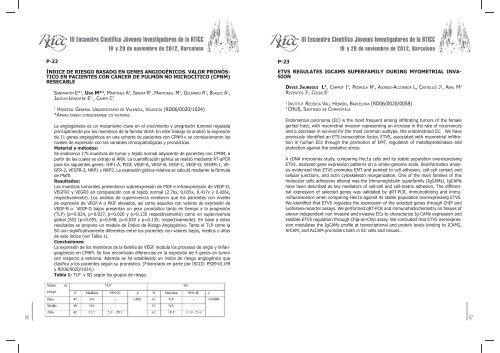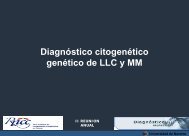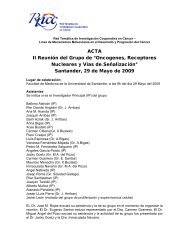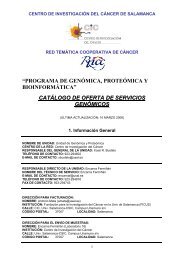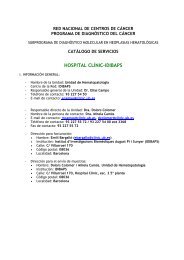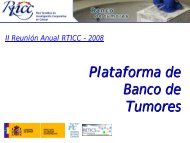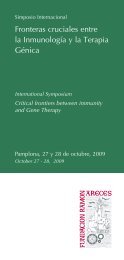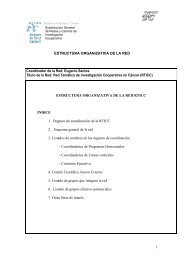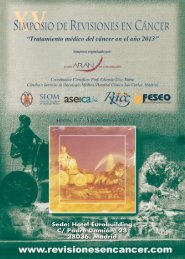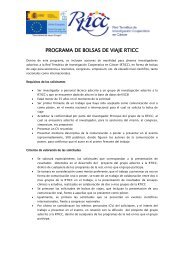Untitled - Red Temática de investigación cooperativa en cáncer
Untitled - Red Temática de investigación cooperativa en cáncer
Untitled - Red Temática de investigación cooperativa en cáncer
You also want an ePaper? Increase the reach of your titles
YUMPU automatically turns print PDFs into web optimized ePapers that Google loves.
P-22<br />
ÍNDICE DE RIESGO BASADO EN GENES ANGIOGÉNICOS. VALOR PRONÓS-<br />
TICO EN PACIENTES CON CÁNCER DE PULMÓN NO MICROCÍTICO (CPNM)<br />
RESECABLE<br />
SANMARTÍN E* 1 , USÓ M* 1 , MARTÍNEZ A 1 , SIRERA R 1 , MARTORELL M 1 , GUIJARRO R 1 , BLASCO A 1 ,<br />
JANTUS-LEWINTRE E 1 , CAMPS C 1<br />
1<br />
HOSPITAL GENERAL UNIVERSITARIO DE VALENCIA, VALENCIA (RD06/0020/1024)<br />
*AMBAS DEBEN CONSIDERARSE CO-AUTORAS<br />
La angiogénesis es un mecanismo clave <strong>en</strong> el crecimi<strong>en</strong>to y progresión tumoral regulada<br />
principalm<strong>en</strong>te por los miembros <strong>de</strong> la familia VEGF. En este trabajo se analizó la expresión<br />
<strong>de</strong> 11 g<strong>en</strong>es angiogénicos <strong>en</strong> una cohorte <strong>de</strong> paci<strong>en</strong>tes con CPNM y se correlacionaron los<br />
niveles <strong>de</strong> expresión con las variables clinicopatológicas y pronósticas.<br />
Material y métodos:<br />
Se analizaron 175 muestras <strong>de</strong> tumor y tejido normal adyac<strong>en</strong>te <strong>de</strong> paci<strong>en</strong>tes con CPNM, a<br />
partir <strong>de</strong> las cuales se extrajo el ARN. La cuantificación génica se realizó mediante RT-qPCR<br />
para los sigui<strong>en</strong>tes g<strong>en</strong>es: HIF1-A, PIGF, VEGF-A, VEGF-B, VEGF-C, VEGF-D, VEGFR-1, VE-<br />
GFR-2, VEGFR-3, NRP1 y NRP2. La expresión génica relativa se calculó mediante la fórmula<br />
<strong>de</strong> Pfaffl.<br />
Resultados:<br />
Las muestras tumorales pres<strong>en</strong>taron sobreexpresión <strong>de</strong> PlGF e infraexpressión <strong>de</strong> VEGF-D,<br />
VEGFR2 y VEGR3 <strong>en</strong> comparación con el tejido normal (2.76x, 0.035x, 0.417x y 0.426x,<br />
respectivam<strong>en</strong>te). Los análisis <strong>de</strong> superviv<strong>en</strong>cia revelaron que los paci<strong>en</strong>tes con niveles<br />
<strong>de</strong> expresión <strong>de</strong> VEGF-A o PlGF elevados, así como aquellos con valores <strong>de</strong> expresión <strong>de</strong><br />
VEGF-B o VEGF-D bajos pres<strong>en</strong>tan un peor pronóstico tanto <strong>en</strong> tiempo a la progresión<br />
(TLP) (p=0.024, p=0.027, p=0.020 y p=0.135 respectivam<strong>en</strong>te) como <strong>en</strong> superviv<strong>en</strong>cia<br />
global (SG) (p=0.055, p=0.048, p=0.020 y p=0.135, respectivam<strong>en</strong>te). En base a estos<br />
resultados se propone un mo<strong>de</strong>lo <strong>de</strong> Índice <strong>de</strong> Riesgo Angiogénico. Tanto el TLP como la<br />
SG son significativam<strong>en</strong>te difer<strong>en</strong>tes <strong>en</strong>tre los paci<strong>en</strong>tes con valores bajos, medios o altos<br />
<strong>de</strong> este índice (ver Tabla 1).<br />
Conclusiones:<br />
La expresión <strong>de</strong> los miembros <strong>de</strong> la familia <strong>de</strong> VEGF modula los procesos <strong>de</strong> angio y linfangiogénesis<br />
<strong>en</strong> CPNM. Se han <strong>en</strong>contrado difer<strong>en</strong>cias <strong>en</strong> la expresión <strong>de</strong> 4 g<strong>en</strong>es <strong>en</strong> tumor<br />
con respecto a estroma. A<strong>de</strong>más se ha establecido un índice <strong>de</strong> riesgo angiogénico que<br />
clasifica a los paci<strong>en</strong>tes según su pronóstico. (Financiado <strong>en</strong> parte por ISCIII: PS09-01149<br />
y RD06/0020/1024.)<br />
Tabla 1: TLP y SG según los grupos <strong>de</strong> riesgo.<br />
P-23<br />
ETV5 REGULATES IGCAMS SUPERFAMILY DURING MYOMETRIAL INVA-<br />
SION<br />
DEVIS JAUREGUI L 1 , CAMPOY I 1 , PEDROLA N 1 , ALONSO-ALCONADA L, CASTELLVÍ J 1 , ABAL M 2<br />
REVENTÒS J 1 , COLÁS E 1<br />
1<br />
INSTITUT RECERCA VALL HEBRÓN, BARCELONA (RD06/0020/0058)<br />
2<br />
CHUS, SANTIAGO DE COMPOSTELA<br />
Endometrial carcinoma (EC) is the most frequ<strong>en</strong>t among infiltrating tumors of the female<br />
g<strong>en</strong>ital tract, with myometrial invasion repres<strong>en</strong>ting an increase in the rate of recurr<strong>en</strong>ces<br />
and a <strong>de</strong>crease in survival for the most common subtype, the <strong>en</strong>dometrioid EC. We have<br />
previously i<strong>de</strong>ntified an ETS transcription factor, ETV5, associated with myometrial infiltration<br />
in human ECs through the promotion of EMT, regulation of metalloproteinases and<br />
protection against the oxidative stress.<br />
A cDNA microarray study, comparing Hec1a cells and its stable population overexpressing<br />
ETV5, analyzed g<strong>en</strong>e expression patterns on a whole-g<strong>en</strong>ome scale. Bioinformatics analysis<br />
evi<strong>de</strong>nced that ETV5 promotes EMT and pointed to cell adhesion, cell-cell contact and<br />
cellular junctions, and actin cytoskeleton reorganization. One of the main families of this<br />
molecular cells adhesions altered was the Immunoglobulin superfamily (IgCAMs). IgCAMs<br />
have be<strong>en</strong> <strong>de</strong>scribed as key mediators of cell-cell and cell-matrix adhesion. The differ<strong>en</strong>tial<br />
expression of selected g<strong>en</strong>es was validated by qRT-PCR, immunobloting and immunofluoresc<strong>en</strong>ce<br />
wh<strong>en</strong> comparing Hec1a against its stable population overexpressing ETV5.<br />
We i<strong>de</strong>ntified that ETV5 regulates the expression of the selected g<strong>en</strong>es through ChIP and<br />
luciferase-reporter assays. We performed qRT-PCR and immunohistochemistry on tissues of<br />
elev<strong>en</strong> in<strong>de</strong>p<strong>en</strong><strong>de</strong>nt non invasive and invasive ECs to characterize Ig-CAMs expression and<br />
validate ETV5 regulation through Chip-on-Chip assay. We conclu<strong>de</strong>d that ETV5 overexpression<br />
modulates the IgCAMs profile at transcriptional and protein levels binding to ICAM2,<br />
NrCAM, and ALCAM promoters both in EC cells and tissues..<br />
66 67


